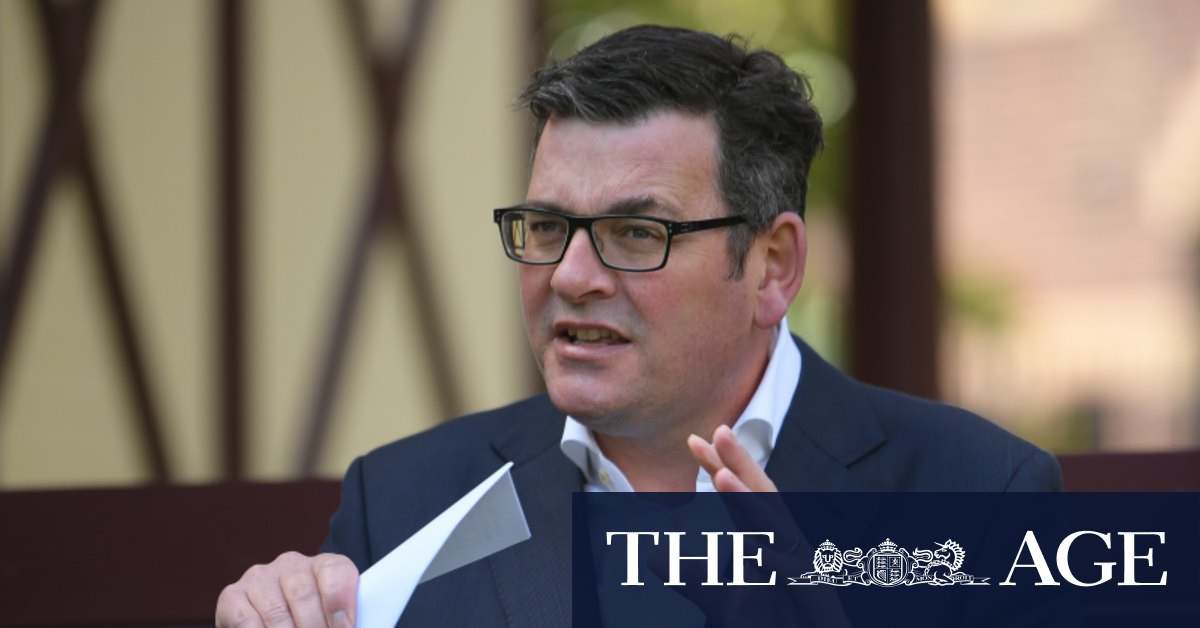Victorias COVID-19 road map revealed
 By Sumeyya IlanbeyUpdated September 19, 2021 â€" 4.37pmfirst published at 12.32pm
By Sumeyya IlanbeyUpdated September 19, 2021 â€" 4.37pmfirst published at 12.32pmVaccines could become mandatory for all authorised workers, teachers, childcare workers, parents of childcare workers, hospitality workers and hospitality patrons as Victoria moves to reopen schools and businesses, under the state government’s road map out of COVID-19 restrictions.
Hospitality venues and places of worship will be permitted to operate outdoors under density limits and outdoor gatherings will be allowed for up to 50 people once 70 per cent of Victorians aged 16 and over have been fully vaccinated.
Mandatory masks will remain.
The re-opening of schools will not be tied to vaccination coverage, with year 12 students allowed to return to face-to-face learning five days a week from October 5.
Prep students will be back to the classroom for three days a week and grades 1 and 2 students two days a week from October 18.
Childcare will open to all children from October 26 if both parents are fully vaccinated, while the remaining year levels will return to school between two and five days a week from that date until November 5 when schools will stay open for all students all week.
Construction will be allowed to resume at full capacity and community sport allowed back on when the state hits 70 per cent second dose coverage, expected around October 26.
Chief Health Officer Brett Sutton is actively considering making vaccines mandatory for several industries when the state begins reopening.
The Burnet Institute’s modelling, which the road map is based on, has an underlying assumption that vaccines will be mandatory for authorised workers, teachers, childcare workers, parents of childcare workers, hospitality workers and hospitality patrons.
Meanwhile, from midnight, Geelong, Surf Coast Shire and Mitchell Shire will be plunged into a seven-day lockdown from midnight tonight. Unlike Melbourne, there will not be a curfew.
Health Minister Martin Foley said the decision for another localised lockdown was made to “avoid devastation†of the virus getting into families and communities.
“The national plan also is predicated on where you have to, you have localised short, sharp lockdowns ... which is why the Chief Health Officer has advised us that we need to take such strong fast short sharp action,†he said.
The government commissioned the Burnet Institute to undertake modelling to help the state ease out of its current restrictions.
It found even under the current lockdown conditions, there was a “moderate†risk of exceeding health system capacity. Based on the current growth in cases, Victoria will hit a peak in seven-day average daily cases of between 1400 and 2900 between October 19 and October 31.
The demand on the healthcare system will grow as a result, with an estimated 1200 to 2500 COVID-19 patients admitted to hospital, and between 260 and 550 people will need treatment in intensive care.
There is expected to be a “second epidemic peak†in mid-December when significant restrictions are eased after the state hits the 80 per cent fully vaccinated coverage, expected around November 5.
When Victoria reaches that milestone, hospitality venues, retail, entertainment venues and places of worship will be allowed to operate indoors under strict density limits. Five visitors will be permitted at homes, and masks will be mandatory indoors.
From Christmas Day, private gatherings in homes will increase to 30 people.
The Burnet modelling found increased COVID-19 testing among vaccinated people would mitigate the potential for a resurgence in cases and reduce the pressure on the healthcare system.
It noted its modelling could be optimistic, and the real-world experience worse than estimated, because it had made a number of assumptions, including schools and childcare could halve its transmission risk through ventilation and other mechanisms; vaccine immunity would not wane over time; compliance would not reduce further; and vaccines were delivered “equally†across the state.
Conversely, the real-world scenario could be better than estimated because the modelling did not factor in the impact of seasonality (when it is possible the warmer weather may reduce transmission); and assumed the current growth rate would continue which is “possibly†biased by recent infections being concentrated in communities with “below average†vaccine coverage.
More to come
correctionAn earlier version of this article said vaccines would be mandated for a range of industries. The Burnet Institute’s modelling, which the road map is based on, has an underlying assumption that vaccines will become mandatory for those sectors. The Chief Health Officer is actively considering those sectors and will make a decision soon.

0 Response to "Victorias COVID-19 road map revealed"
Post a Comment